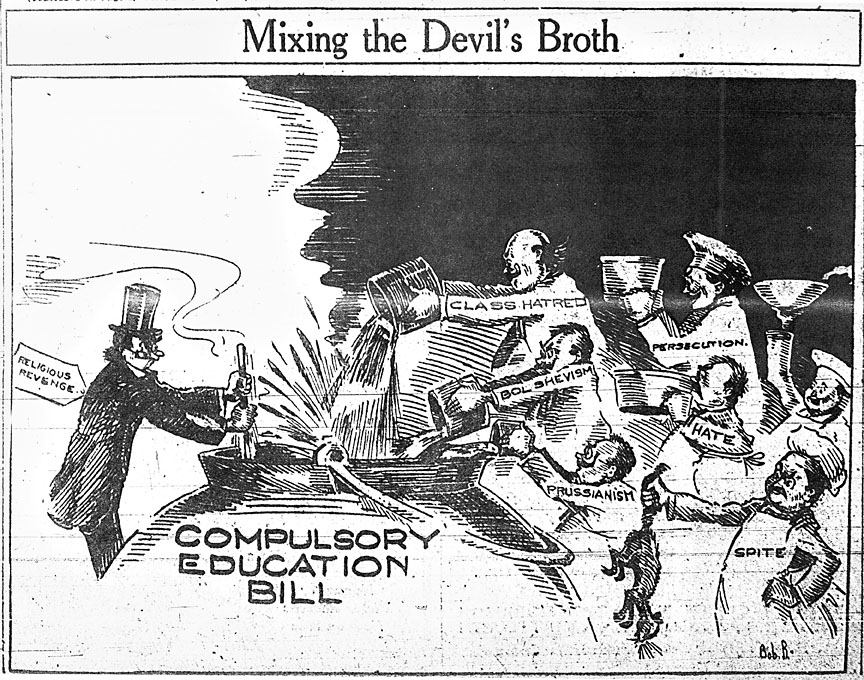Overview
Pierce vs. Society of Sisters, by Robert Bunting
On June 1, 1925, in Pierce v. Society of Sisters of the Holy Names of Jesus and Mary (268 U.S. 510), the U.S. Supreme Court declared unconstitutional an Oregon law making public school attendance mandatory. In its ruling, the court upheld the right of private schools to exist and the right of parents to govern their children’s education. “The child is not the mere creature of the state,” the Court held; “those who nurture him and direct his destiny have the right, coupled with the high duty, to recognize and prepare him for additional obligations.”
The Oregon Compulsory Education Bill, which appeared as an initiative on the November 7, 1922, state ballot, compelled children between the ages of eight and sixteen to attend public schools, “with some exceptions based on age, health and access to a parent or private teacher.” Parents or guardians who broke the law would be fined “from five to one hundred dollars” and could be imprisoned for “from two to thirty days.”
In the end, the initiative passed by an almost 53 percent margin, with 115,506 votes in favor and 103,685 opposed. Although the measure was not to become operative until September 1, 1926, opponents immediately took their case to the federal court.
Learn more about the Compulsory Public School Attendance Bill: Pierce vs. Society of Sisters, by Robert Bunting
Content Standards
- HS.1 Analyze the impact of constitutional amendments on groups, individuals, institutions, national order.
- HS.4 Examine institutions, functions and processes of United States government.
- HS.6 Examine the institutions, functions, and processes of Oregon's state, county, local and regional governments.
- HS.7 Analyze political parties, interest and community groups, and mass media and how they influence the beliefs and behaviors of individuals, and local, state, and national constituencies.
- HS.65 Identify and analyze the nature of systemic oppression on ethnic and religious groups, as well as other traditionally marginalized groups, in the pursuit of justice and equality in Oregon, the United States and the world.
- HS.67 Evaluate historical sources for perspective, limitations, accuracy, and historical context.
- HS.68 Select and analyze historical information, including contradictory evidence, from a variety of primary and secondary sources to support or reject a claim.
- HS.69 Create and defend a historical argument utilizing primary and secondary sources as evidence.
Additional Sources
Oregon Encyclopedia Entries
Bunting, Robert. "Pierce vs. Society of Sisters" The OE
Toy, Eckard. "Ku Klux Klan." The OE
Articles and Books
Holsinger, M. Paul. "The Oregon School Bill Controversy." Pacific Historical Review 37:3 (Aug. 1968): 327-341.
Abrams, Paula. Cross Purposes: Pierce v. Society of Sisters and the Struggle over Compulsory Public Education. Ann Arbor: The University of Michigan Press, 2009.
Newspaper Articles
“Portals of the Nation’s Future Free Public Schools.” Morning Oregonian_, November 6, 1922, p. 6.
“The School Monopoly Bill has a Misleading Name!” The Maupin Times_, October 19, 1922.
Additional Lesson Plans
Digital Public Library of America. Primary Source Sets Lesson Plan. Second Ku Klux Klan and The Birth of a Nation
Cite
The OE. "Mixing the Devil's Broth": The KKK and the Compulsory Education Act of 1922. 2020. Retrieved from The Oregon Encyclopedia, https://www.oregonencyclopedia.org/packets/1. (Accessed December 25, 2025.)Teacher Guide
1) Have students examine the following documents. 1. "Devil's Broth" political cartoon from 1922 and the 2. "Advertisement, Vote 314 x Yes" from 1922. According to the supporters of each document, what are the arguments for and against the Compulsory Education Act? (H.S. 60). Ask students how these documents use facts, opinion, stereotypes, and persuasion to argue their case (H.S. 58).
2) Have students analyze the following documents: 3. KKK meets with Portland Leaders, 1921 photo; 4. The Truth About the KKK , 1921 flyer and the 5. Portland KKK, 1922, photo. How did the Scottish Rite Masons and the KKK influence political, community, and religious leaders to support their political agenda and beliefs in Oregon? Provide specific examples (H.S.30).
3) Have students analyze the following documents: 6. Proclamation Against the KKK, 1922; 7. From W.R. Burner to Governor Olcott, 1923; 8. State of Oregon vs. Hill Military Academy, 1925. These documents represent the concerns political and judicial leaders had about the Ku Klux Klan and its plan to eliminate private schools. What arguments do they use to oppose the KKK and the Compulsory Education Act?
4) After examining all of the documents have students answer the following questions. How did the KKK exert its influence in Oregon? How was the KKK challenged in Oregon?
5) What are some contemporary hate groups that operate in Oregon or the United States today? Do these groups have the same ideologies as the KKK? How do these groups spread their ideologies through the press, media, or political organizations? Use the Southern Poverty Law Center web site to begin your research.

